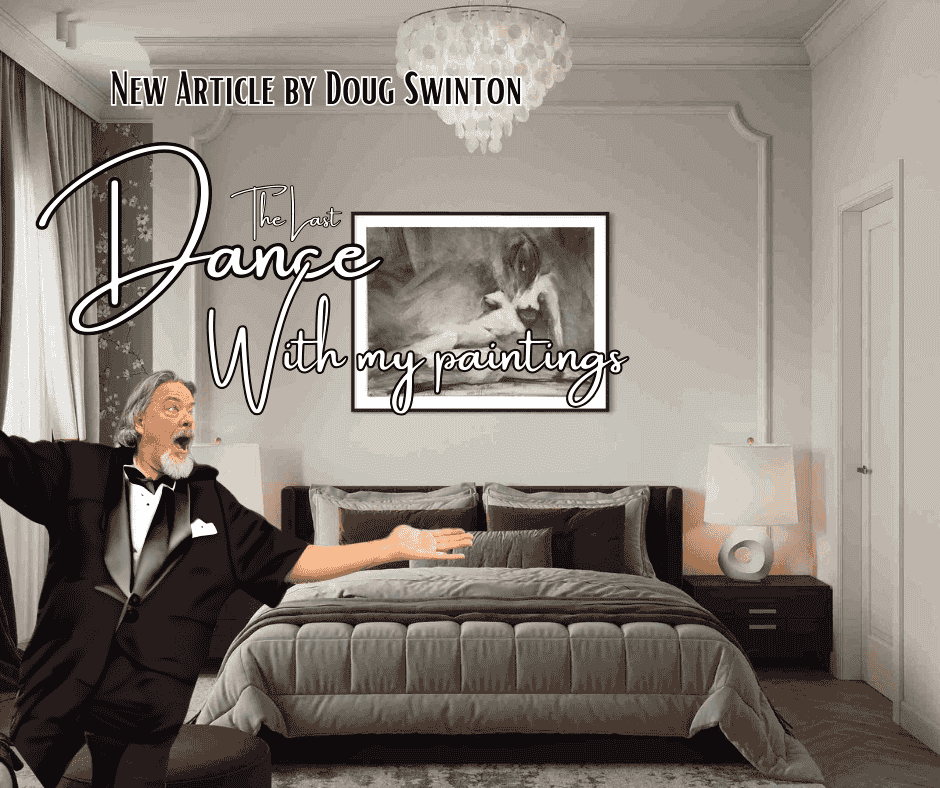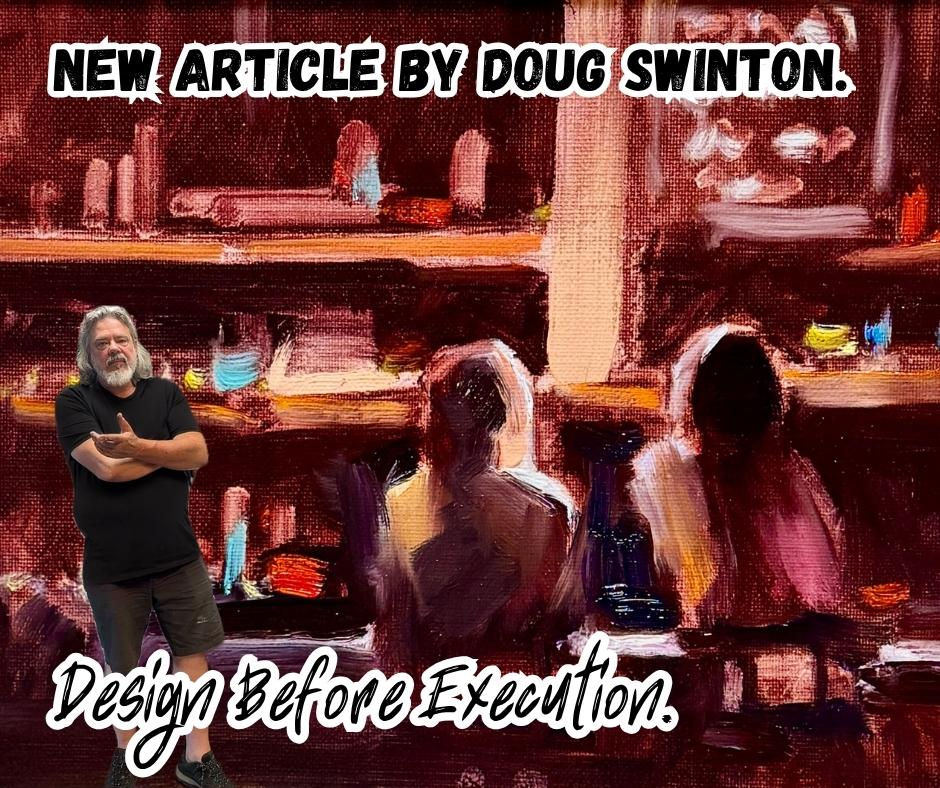10 Painting Tips - Painting Secrets #39
- Doug Swinton

- Jun 4, 2015
- 3 min read
Updated: Nov 18, 2020
By Doug Swinton

1. Focal Point: Choose one! The hardest part about painting is the vast buffet of visual stimuli Mother Nature puts out before you. Whether you are outdoors, painting a still life or using a photo you need to simplify thing so you don’t get over whelmed. If you are getting confused then most certainly the viewer will be confused. If you start by saying “my painting is about the barn and the cows and the tree, oh and for sure the puffy cloud and the fence… too much information!!!! Think is my painting going to be about the foreground, the middle ground or the background/ sky. One of these needs to be dominate and be a dominant shape.
2. Sketches: Keep making them until there’s a good composition with leading lines in to focal point. A bad composition can only lead to a bad painting. Think thumbnails. Thumbnails should be just that; a simple small sketch with just the bear bones of info to set you up for the kapowie painting you want. Try using a black sharpie marker to simplify your thumbnail sketches.
3. Squint! To see values, simplify. Even if you’re using a photo, I know you’ll look like your mother trying to read the white pages but I swear it works. Half clothes your eyes and look at what your painting, that’s the look you should be going for. Just don’t squint when you look at your painting or you’ll have a slurried mess.
4. Colour Key: Decide: Will the painting be predominantly Warm or Cool, High key or Low key, Predominant hue? No fence sitters here please. Make it really lean to one side or the other. One great way to tell if you’re on the right track is to step back and have a look at your palette. If it has a predominant temperature to it or one hue colour is over most of the surface, Bobs your uncle. If you can’t see dominance in the palette then I would bet my morning donut you don’t have one on your painting.
5. Canvas: Transpose thumbnail to canvas, creating large puzzle piece shapes. You should have no more than five different sized shapes in your initial set up.
6. Under-paint: Loose, sketchy monochrome under painting of shapes, darks, and mid tones with very diluted paint. This will set up your values. If it looks good in a monochrome and you don’t screw up, and follow your values: Roberts your Mothers Brother! Remember just because its dark doesn’t mean it’s black.
7. Paint Large Shapes:Match the value in your underpainting in a colour again by squinting you will see the match.
8. Colour Patches:Break larger shapes of matched colour into smaller patches of colour and light, matching or slightly exaggerating the colour. Try using a bigger brush than you would expect. A great way to not get to over detailed is to use a brush one size bigger than you think you need. Small brushes can make itty-bitty marks and itty-bitty marks can cause too much noise (detail) in your painting too early. Save the noise for right near the end.
9. Highlights & Accents:Add thick LIGHT paint, thin dark accents, and occasional splashes of “broken” colour for VIBRANCY. Add in the noise. Fence posts telephone lines a few people on a beach, car tail lights coconuts in a tree, twinkling leaves in the sun etc.
10. Edges:Put a dab of COMPLEMENTARY colours around edges of focal points to pop. Soften and/or cool receding edges that are not near the focal point.
That’s ten but wait don’t order yet…. here’s a freebie!
11. STOP:It’s a field study! As Robert Genn once told me “ better 20% unfinished than 2% over worked.
Bam! Now what are you going to paint today?
Your friend in art, Doug.
Doug “These are not the droids you're looking for” Swinton








Are you scared to attend your company party because you need a partner? If so, you can make everyone jealous by bringing our call girls to your office party. You know how beautiful, gorgeous, and sensual our women are. To ensure it is all hers, they are trained on how to dress for a party.
Call Girls Service Near The Leela Ambience Hotel Gurgaon || Call Girl Near Hotel The Manor New Friends Colony || Call Girls Near Hotel Taurus Sarovar Portico Gole Market || Call Girl Near The Muse Sarovar Portico Hotel Kapashera || Call Girls Near The Ocean Pearl Retreat Hotel Chattarpur
AV在线看 AV在线看;
自拍流出 自拍流出;
国产视频 国产视频;
日本无码 日本无码;
动漫肉番 动漫肉番;
吃瓜专区 吃瓜专区;
SM调教 SM调教;
ASMR ASMR;
国产探花 国产探花;
强奸乱伦 强奸乱伦;
AV在线看 AV在线看;
自拍流出 自拍流出;
国产视频 国产视频;
日本无码 日本无码;
动漫肉番 动漫肉番;
吃瓜专区 吃瓜专区;
SM调教 SM调教;
ASMR ASMR;
国产探花 国产探花;
强奸乱伦 强奸乱伦;
代发外链 提权重点击找我;
谷歌蜘蛛池 谷歌蜘蛛池;
Fortune Tiger…
Fortune Tiger…
谷歌权重提升/ 谷歌权重提升;
谷歌seo 谷歌seo;
谷歌霸屏 谷歌霸屏
蜘蛛池 蜘蛛池
谷歌快排 谷歌快排
Google外链 Google外链
谷歌留痕 谷歌留痕
Gái Gọi…
Gái Gọi…
Dịch Vụ…
谷歌霸屏 谷歌霸屏
负面删除 负面删除
币圈推广 币圈推广
Google权重提升 Google权重提升
Google外链 Google外链
google留痕 google留痕
代发外链 提权重点击找我;
谷歌蜘蛛池 谷歌蜘蛛池;
Fortune Tiger…
Fortune Tiger…
谷歌权重提升/ 谷歌权重提升;
谷歌seo 谷歌seo;
谷歌霸屏 谷歌霸屏
蜘蛛池 蜘蛛池
谷歌快排 谷歌快排
Google外链 Google外链
谷歌留痕 谷歌留痕
Gái Gọi…
Gái Gọi…
Dịch Vụ…
谷歌霸屏 谷歌霸屏
负面删除 负面删除
币圈推广 币圈推广
Google权重提升 Google权重提升
Google外链 Google外链
google留痕 google留痕